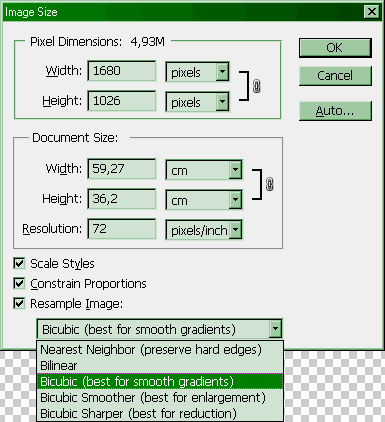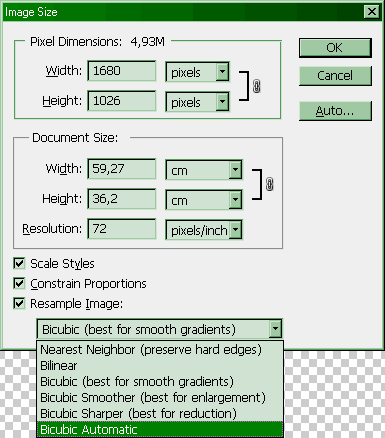User experience versus innovations in interfaces
More recently, Adobe introduced Creative Suite 6 with a number of new features, major and minor innovations. As usual, many users began to update, expecting a variety of improvements.
However, some of the innovations turned out to be quite small, but they caused a wave of bewilderment and conversations. On the example of one such innovation, I would like to reflect on the users' attachment to the familiar interface and on possible ways to circumvent such situations when developing and updating software.
Photoshop CS6 introduced many new features. But the change that will be discussed is just a small touch in the interface, not worthy of mention in What's new .
In the Image Size dialog through which the image is resized, there is the Resample Image option, for which, in turn, there is a drop-down list of interpolation options. Previously (I can’t say exactly which version, but for more than ten years, exactly, and up to the penultimate version of CS5 inclusive), it consisted of the following items:
In reality, it looked like this:

But in CS6, the “Bicubic Automatic” item was added last, it was made the default option, and everything began to look like this:

This new item does nothing completely new. In fact, if it is selected, the bicubic interpolation method is automatically selected from the options listed above. That is, the user is given the opportunity not to touch this list at all - Photoshop will determine whether the image is enlarged or reduced and use the recommended method.
From the point of view of developers - it is logical.
Users use Photoshop for a variety of purposes. Someone - for color grading and preparing images for printing. And someone - to reduce their photos before publishing on the network. And many have their own view on how the image should look. One wants their photos to look “sharper” on the network, that is, to have high contrast in the field of color transitions. Others, on the contrary, consider the use of aggressive sharpening a bad form.
Just the latter turned out to be dissatisfied with the innovation, since to reduce the photo, they used before not Bicubic Sharper (now used automatically by default to reduce), but other interpolation options.
It can be difficult for a software developer or just a person with a technical mindset to imagine that this has become a problem for someone. “Well, is it difficult to change the option in the drop-down list?” Such a person will say, and he will be right in his own way. (I myself read about the first description of this problem for about five minutes, trying to understand where the problem itself was, and why this situation was worth discussing at all.) But this approach is far from common for everyone.
In fact, users, accustomed to the fact that the Image Size dialog has not changed for more than a dozen years, perceived it as a kind of axiom. The operating system interface itself was changing, Photoshop versions were changing, and the logic of the dialogue remained the same. It has become a deeply rooted experience.
When the principle of the function of the resizing function changed, users approached the situation not from the position of logic, which would easily prompt the answer immediately after reading the new list of options, but from the position of empirical thinking, that is, exclusively of their experience. And in the experience there was nothing about the automatic selection of options. The result ceased to suit, but what to do was incomprehensible.
Some inquiring minds eventually solved the problem. But in order to find out what changed, they needed to experiment and gain experience. Moreover, the experimental results turned out to be one-sided (they set them only in the context of image reduction). The word “Automatic” was ultimately interpreted as “it automatically sharpens something there,” and not as an indication of automatic selection of options. Moreover, the complete similarity of the Automatic and Sharper options did not lead to any thoughts of some users, at least at first.
In order not to be unfounded and so that this strange at first glance story does not look fictitious, here are at least two proofs (see also comments): study No. 1 and study No. 2 .
To prevent such a situation, simple steps could be taken. It would be hard to say which one would be most effective without testing on live users. The general point of what would have to be done is to give the user the opportunity to see how the automatic selection works, and that this is not another interpolation method.
I’ll
list what came to my mind: - the list remains as before, but to the right of the Resample checkbox is added the “Automatic (Bicubic Sharper / Smoother)” checkbox, which disables the drop-down list when choosing;
- when choosing Automatic and entering values of a new size, to the right of the list write which method was automatically selected;
- name the item not “Bicubic Automatic”, but “Automatic (Bicubic Sharper / Smoother)” so that the word “automatic” is not perceived as the name of the method.
However, some of the innovations turned out to be quite small, but they caused a wave of bewilderment and conversations. On the example of one such innovation, I would like to reflect on the users' attachment to the familiar interface and on possible ways to circumvent such situations when developing and updating software.
What changed
Photoshop CS6 introduced many new features. But the change that will be discussed is just a small touch in the interface, not worthy of mention in What's new .
In the Image Size dialog through which the image is resized, there is the Resample Image option, for which, in turn, there is a drop-down list of interpolation options. Previously (I can’t say exactly which version, but for more than ten years, exactly, and up to the penultimate version of CS5 inclusive), it consisted of the following items:
- Nearest Neighbor (preserve hard edges)
- Bilinear
- Bicubic (best for smooth gradients)
- Bicubic Smoother (best for enlargement)
- Bicubic Sharper (best for reduction)
In reality, it looked like this:

But in CS6, the “Bicubic Automatic” item was added last, it was made the default option, and everything began to look like this:

What is up to Adobe
This new item does nothing completely new. In fact, if it is selected, the bicubic interpolation method is automatically selected from the options listed above. That is, the user is given the opportunity not to touch this list at all - Photoshop will determine whether the image is enlarged or reduced and use the recommended method.
From the point of view of developers - it is logical.
How users reacted
Users use Photoshop for a variety of purposes. Someone - for color grading and preparing images for printing. And someone - to reduce their photos before publishing on the network. And many have their own view on how the image should look. One wants their photos to look “sharper” on the network, that is, to have high contrast in the field of color transitions. Others, on the contrary, consider the use of aggressive sharpening a bad form.
Just the latter turned out to be dissatisfied with the innovation, since to reduce the photo, they used before not Bicubic Sharper (now used automatically by default to reduce), but other interpolation options.
It can be difficult for a software developer or just a person with a technical mindset to imagine that this has become a problem for someone. “Well, is it difficult to change the option in the drop-down list?” Such a person will say, and he will be right in his own way. (I myself read about the first description of this problem for about five minutes, trying to understand where the problem itself was, and why this situation was worth discussing at all.) But this approach is far from common for everyone.
What really happened
In fact, users, accustomed to the fact that the Image Size dialog has not changed for more than a dozen years, perceived it as a kind of axiom. The operating system interface itself was changing, Photoshop versions were changing, and the logic of the dialogue remained the same. It has become a deeply rooted experience.
When the principle of the function of the resizing function changed, users approached the situation not from the position of logic, which would easily prompt the answer immediately after reading the new list of options, but from the position of empirical thinking, that is, exclusively of their experience. And in the experience there was nothing about the automatic selection of options. The result ceased to suit, but what to do was incomprehensible.
Some inquiring minds eventually solved the problem. But in order to find out what changed, they needed to experiment and gain experience. Moreover, the experimental results turned out to be one-sided (they set them only in the context of image reduction). The word “Automatic” was ultimately interpreted as “it automatically sharpens something there,” and not as an indication of automatic selection of options. Moreover, the complete similarity of the Automatic and Sharper options did not lead to any thoughts of some users, at least at first.
In order not to be unfounded and so that this strange at first glance story does not look fictitious, here are at least two proofs (see also comments): study No. 1 and study No. 2 .
How to avoid it
To prevent such a situation, simple steps could be taken. It would be hard to say which one would be most effective without testing on live users. The general point of what would have to be done is to give the user the opportunity to see how the automatic selection works, and that this is not another interpolation method.
I’ll
list what came to my mind: - the list remains as before, but to the right of the Resample checkbox is added the “Automatic (Bicubic Sharper / Smoother)” checkbox, which disables the drop-down list when choosing;
- when choosing Automatic and entering values of a new size, to the right of the list write which method was automatically selected;
- name the item not “Bicubic Automatic”, but “Automatic (Bicubic Sharper / Smoother)” so that the word “automatic” is not perceived as the name of the method.
